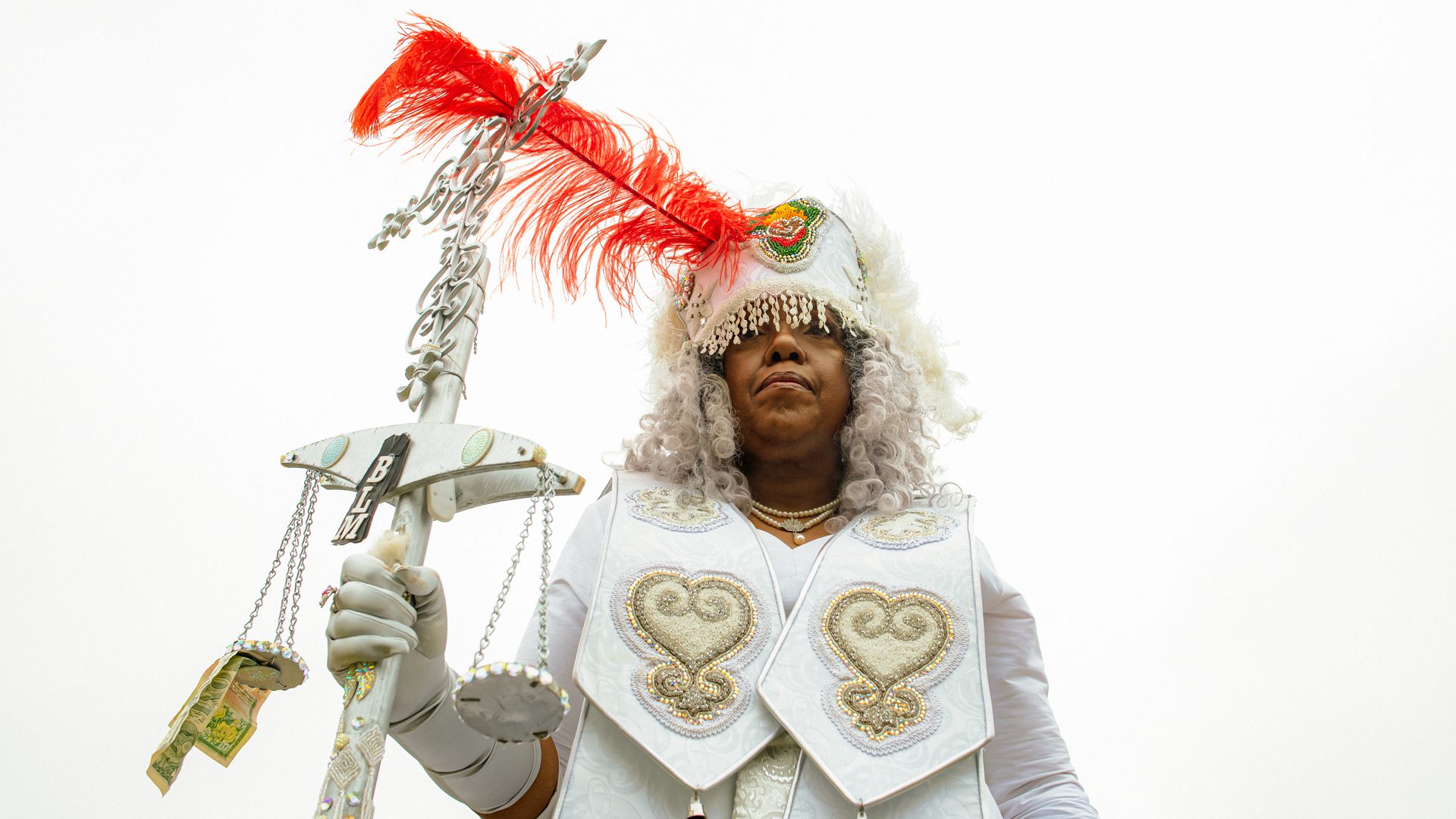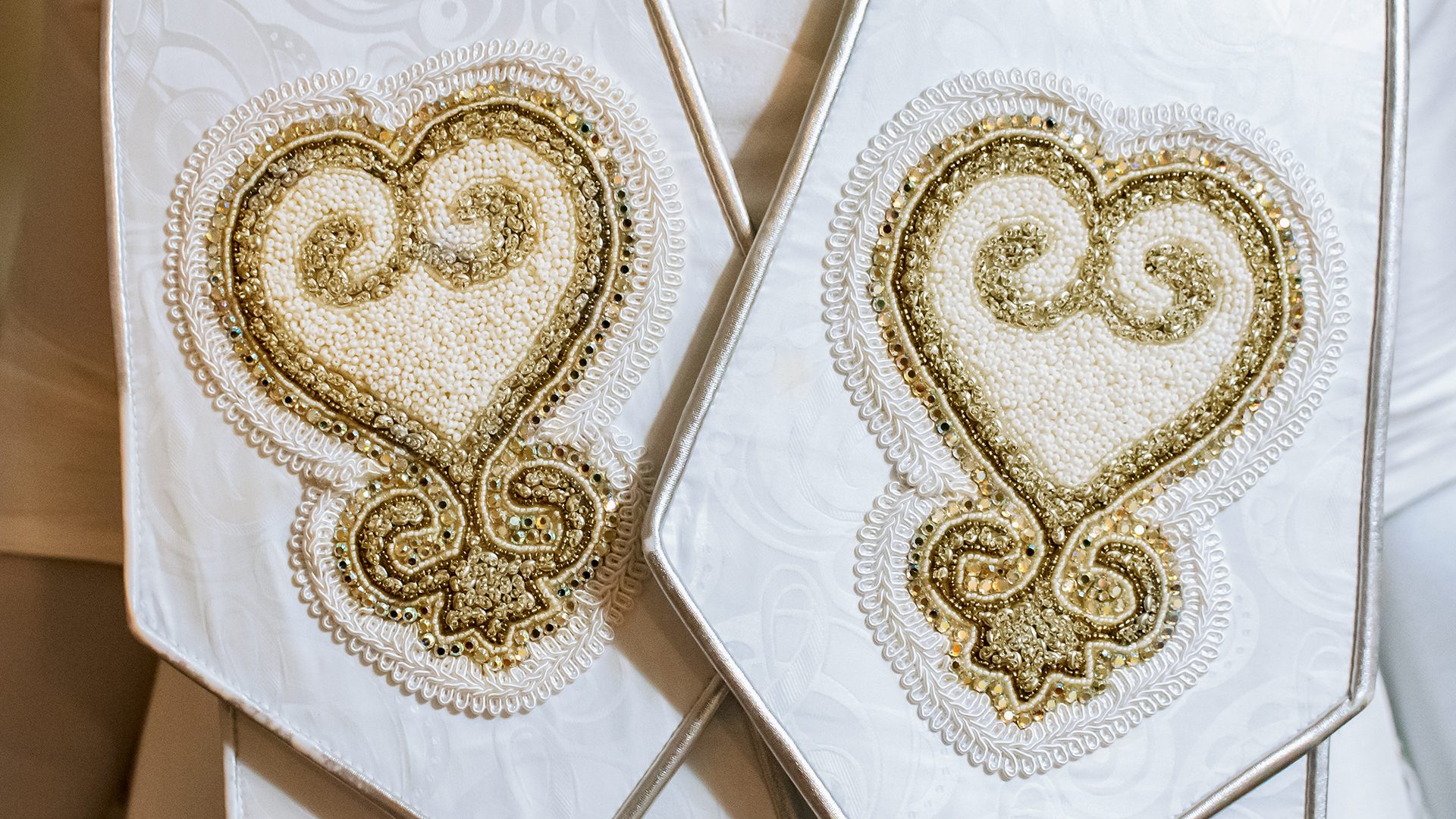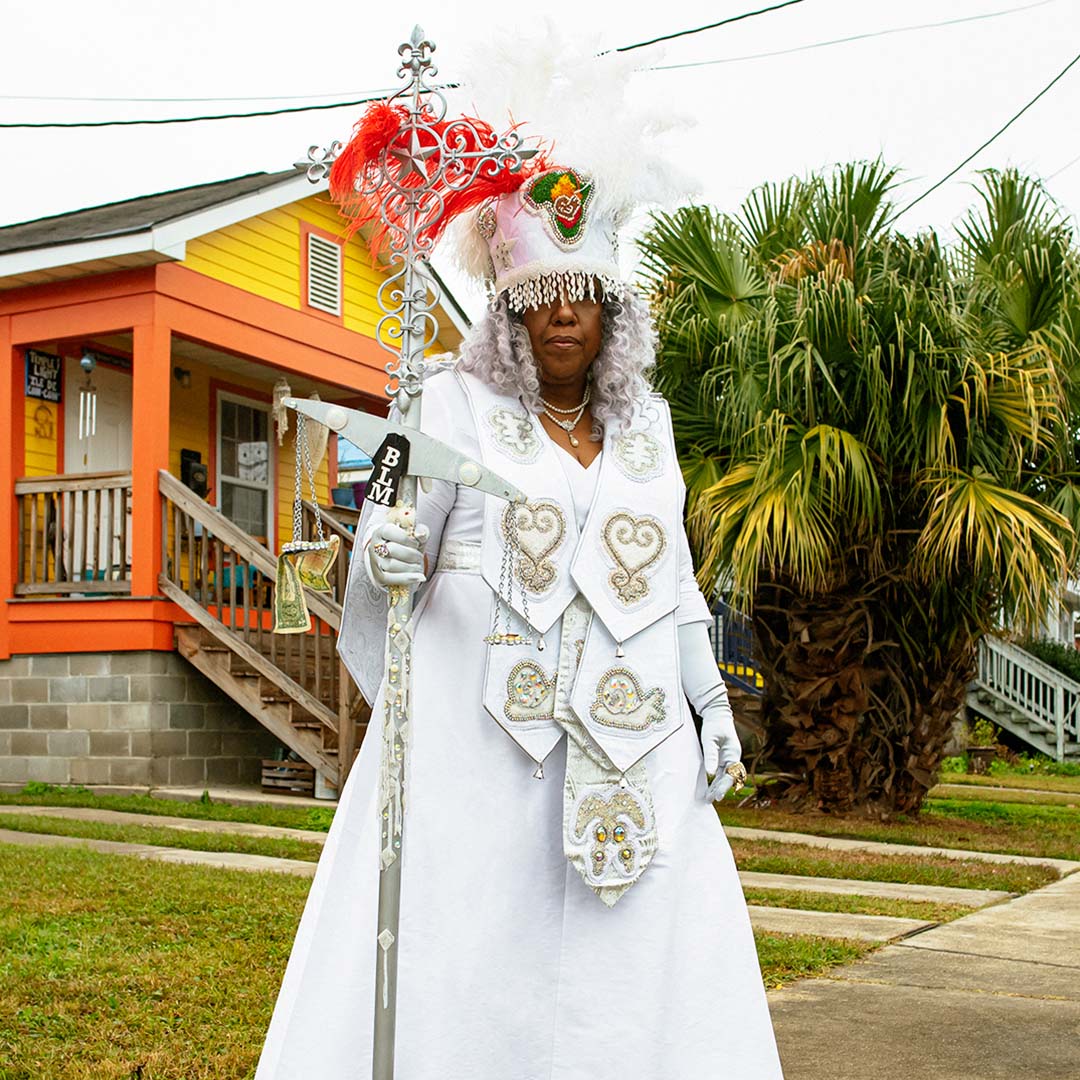Blog editor’s note: This #BlackHistoryMonth, 23andMe employees are celebrating joy and resilience in the Black and African diaspora through events, art, and conversations. We’ve also curated a series of guest blogs about people who embody that joy and resilience – and are harnessing these strengths to uplift their communities and create a better future.
By Imani Mixon
Cherice Harrison-Nelson’s hair is wrapped in a black and wine head scarf with a red feather peeking out from the side. The 62-year-old artist and educator has on medium sized hoop earrings, a black, red, and gold beaded necklace and a festive butterfly brooch.
Even over Zoom, she looks royal.
Cherice regularly honors her lineage as a Mardi Gras Indian and a member of the maroon society of self-emancipated Black folks by crafting and wearing intricately handmade traditional suits. Her late father, Donald Harrison, Sr. ushered the family into the Mardi Gras Indian tradition as Big Chief of the Guardian of the Flames, a group he formed to emphasize the importance of Mardi Gras traditions that affirm Blackness. Cherice continues this work as Big Queen of the Guardian of the Flames and is commonly known as Queen Reesie.
In 1994, she was awarded a Fulbright that allowed her to travel to Ghana and Senegal to further research African cultural traditions. Although our mid-afternoon interview features one of the more tame examples of her unique attire, meeting her feels like a joyful occasion.
“As the Guardians of the Flame, maroon society, I feel like we have emancipated ourselves from all the ideals, both literal and metaphorically that restrict us in ways that we don’t have to accept. I don’t want to be tethered to anything except the love for my family and my community. I want to have free will, to dress the way I want,” says Cherice .
It’s no surprise that Cherice ’s audacious attire draws attention, but one day back in 2016 it earned her a new friend.

Photo by Trenity Thomas
Sisterly Love
She met Skyla Hearn, a Chicago-based archivist and special collections librarian, while attending a Cultural Heritage and Social Change Summit. Harrison-Nelson was preparing to lead an educational performance about the traditions and history of Mardi Gras Indians and she was wearing a purple lace dress and a matching Nigerian gele. Hearn says she knew Queen Reesie was someone special.
Hearn and Harrisson-Nelson grew to become sisterfriends — the kind you meet for dinner when they’re in town, the kind who can send texts that would be shockingly probing if they came from someone else, but are received as alarmingly sweet text check-ins instead.
“Are you being radical in your self-care?”

Photo by Trenity Thomas
“Do you need help with that?”
Hearn knows that the warm accountability of friendship is what has kept folks alive for generations. Cherice knows this too; it isn’t the first time that someone lovingly inquired about her health.
On June 23, 2011, Cherice recalls being at a Winn Dixie grocery store across the Mississippi River from her downtown neighborhood in New Orleans’ 9th Ward when she received a call from her doctor’s office.
“I have the results of your test. Do you want them over the phone or do you want to come in?,” asked the nurse on the other end of the line.
Cherice agreed to hear her results on the phone, but as soon as the nurse began speaking, her words came out in a muffled garble, it sounded like Charlie Brown’s teacher.
“Wait, let me call my sister and you tell her, whatever you’re saying, that sounds like gibberish to me,” Cherice interjected.
Cherice gave the nurse her younger sister Cara’s number, then Cara relayed the conversation she’d had with the nurse. Her older sister was diagnosed with breast cancer. Cara decided to accompany Cherice to her preoperative appointments, prepared to take notes and ask relevant questions about what to expect like the risks of medication, complications from treatment, and if her sister’s life expectancy would be impacted.
After a series of demeaning and otherwise unresponsive interactions with doctors and nurses, Cherice found an old-school doctor, Dr. Myron E. Moorehead, the kind who has tabletop anatomical models of reproductive organs. He showed her exactly what he would do and told her what she needed to do to prepare for an accompanying procedure.
“I knew that he cared about me and I felt I could put my life in his hands and it would be okay. Those other doctors, I don’t think I would have wanted to put my life in their hands,” says Cherice .
It’s been 11 years since her breast cancer diagnosis and 17 years since Hurricane Katrina, which Cherice refers to as “the August 25, 2005 federal levee failure.” She has survived two life-changing events that have altered her view on both physical and mental health. She understands just how quickly things can change for the better or the worse.
“It was so hard being here, so hard working here, healthcare would have been at the bottom of my list. For me, survival didn’t necessarily include health checkups. Being happy enhances your ability to take care of yourself. When you’re depressed, you know your whole world is kind of turned upside down,” says Cherice.
A New Wellness Routine
What was once an after-thought has become a major priority. Now, she spends the first few minutes of each morning envisioning what she wants for her life. Every day, good health tops her list. From moment to moment, Cherice has gotten into the rhythm of choosing herself. Sometimes that means parking farther from a store entrance to get a few steps in. Other times it means buying small batch ice cream from a local vendor and slowly eating small scoops in a fancy bowl with a fancy spoon.
“If you take care of your health, then you can do all the things that enhance your life that we need to do as humans to to survive. It’s just about loving yourself, and loving yourself the most,” says Cherice .
One of the most recent, more public acts of radical self-care for Cherice is acknowledging that she will no longer wear her sacred Carnival suits for performances or appearances or participate in Carnival the way she has in the past. Carnival season starts on January 6th and extends through Mardi Gras Day, which is also known as Carnival Day. This will be her last year strolling around the streets of New Orleans in her Carnival suit on Mardi Gras Day. Starting in 2023, you’ll only be able to catch Cherice in her Carnival suits for her late father’s birthday celebrations — his birthday falls during Carnival season and marks a time of remembrance for the Harrison family. While it was never just a performative gesture, the creation of her Carnival suits have grown even more intimate and laborious over time. By creating boundaries around how she wants to show up as a Mardi Gras Indian, she is relieving herself of the responsibility of automatically inviting others into a tradition that they may not understand or revere.
“The [suit] I wear on Carnival Day, it really is spiritual. It’s like putting on me and I don’t want to use those in that manner anymore,” says Cherice.

Cherice takes that seriously — weaving, beading, patching, and feathering to make ceremonial clothing that draws from and oftentimes illustrates the most resonant moments of her life. When the ensemble is as complete as it can be, it becomes an archive of sorts. Her suits are on display at the Donald Harrison, Sr. Museum named after her father that’s just two blocks from her house and on family land. Her suits are also currently on view at The New Orleans African American Museum in Treme, The McKenna Museum of African-American Art, and the Baton Rouge African American Museum.
“It takes a lifetime because everything you put into a suit is the sum total of your life,” says Cherice .
For this year’s Carnival, she is honoring her ancestors and creating a memorial suit. Cherice can trace her ancestral line pretty far back. She has a bill of sale regarding her great great grandfather Madison Briscoe, who was born in 1809 and enslaved in 1820 when he was just 11-years-old. Although she can go back for generations, this suit in particular will honor friends, mentors, family members and more recent ancestors. Cherice has begun collecting and referencing their favorite things – hobbies, colors, and animals to select the right way to adorn her suit. She will incorporate a horse for her uncle, a butterfly brooch for her mentor, and a lipstick for another friend.
“He’ll tell me what I’m supposed to create for him. The ancestors are really real and they speak to me,” says Cherice .
As Cherice continues on the path to living life on her own terms, her journey reminds us that the first step to any kind of healing begins with listening.
Imani Mixon is a long-form storyteller living in Detroit. You can learn more about her work here.


